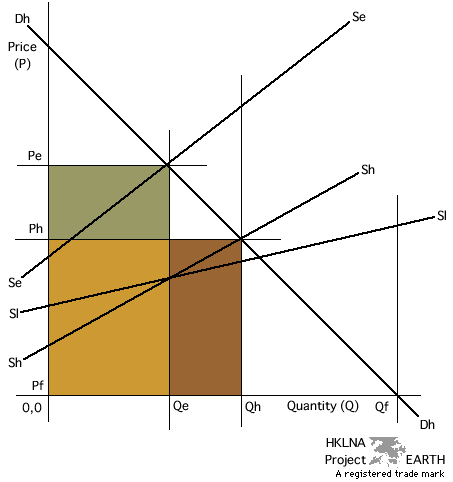|
 |
||||||||
| previous page (graphs 5 and 6) | project index | next page |
|
 |
||||||||
| Industry Revenue at Ph (graph | index) | |||
|
Ph · Qh The area described by the multiplication of Ph and Qh describes the revenue received by the English language industry for the provision of Qh high-level competent individuals to government, industry, and the general public at Ph. As such it is the amount that government, industry, and the general public must pay in order to obtain high-level English language competence. |
|||
| Industry Revene at Pe (graph | index) | |||
|
Pe · Qe The area described by the multiplication Pe and Qe describes the revenue received by the English language industry for the provision of high-level competent individuals to government, industry, and the general public at Pe. Like the quantity Ph · Qh, Pe · Qe is the amount government, industry, and the general public must pay in order to obtain high-level competent individuals. Those who would argue that industry must pay more for fewer individuals in a socially efficient market would be both right and wrong. Though the amount that government, industry, and the general public would have to pay for each high-level competent individual would be higher and the number employed smaller, it is by no means certain that the total amount paid would be more. This is because the amount paid depends on the price elasticity of demand for high-level English language competence. In other words, because government, industry, and the general public would pay more for each high-level competent individual, they would employ these individuals more efficiently and therefore require fewer for the same or similar gain. |
|||
| Price Elasticity of Demand (graph | index) | |
|
The price elasticity of demand at any given point along a demand curve is equal to the percent change in quantity brought about by a percent change in price. When the price elasiticity of demand is large, a small rise in price results in a much larger decrease in the amount of the good or service purchased. This is because those who utilize the good or service can easily find substitutes for it. Although for some the price elasticity of demand will be small, for many others it is likely to be large. Thus, it is difficult to know whether the market for high-level English language competence is elastic or inelastic until the elasticy of the market is actually measured. In the meantime one should not place too much emphasis in the words of those who insist that expenditure will increase with a rise in price for high-level English language competence. |
| previous page (graphs 5 and 6) | top | next page |